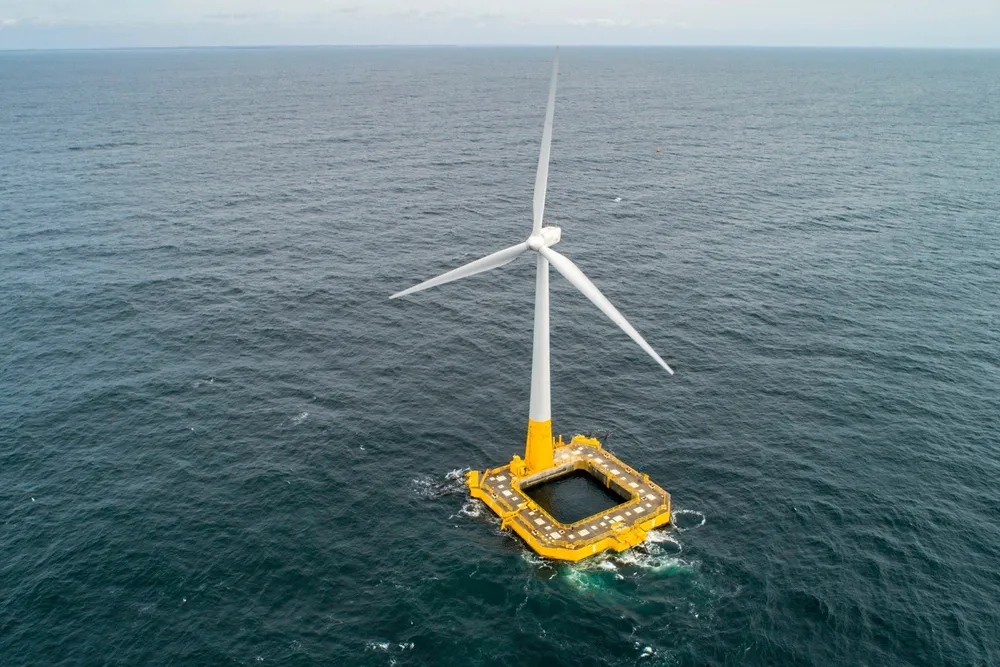'Maybe with Mingyang' | Analysis suggests French floating tender may founder without Chinese turbines
Cheaper non-European turbines may be the way to make agreed strike price work, analysis warns, though project developer insists “we are not crazy.”

The winning bid for France’s debut large-scale floating wind tender is "not likely to be feasible" unless cheaper Chinese turbines are used, offshore wind specialist Aegir Insights has warned, amid concerns that failure to make this trailblazing tender work could deal the entire sector a major setback.
The AO5 Contracts for Difference tender was fêted as the first competitive allocation for floating wind on a commercial scale, demonstrating French determination to push forward with its plans to build up its offshore wind capacity.
Celebrating the win earlier this month, BayWa r.e's CEO Matthias Taft described Pennavel as a “game-changing project, which will act as a reference point for future floating wind farms across the globe.”
But a detailed analysis of the tender from market intelligence firm Aegir Insights questioned whether the AO5 was perhaps more of a "breakdown" than a “breakthrough" for the floating wind sector.
BayWa and Elicio’s winning bid of was significantly below the average of the six consortiums – €102/MWh after the bid ceiling of the auction had been set at €140/MWh. Turbine specification in the bidding documents ranged from 20MW to 23.3MW, Aegir noted.
Chinese hardware?
The CfD result “sent shock waves through the industry,” said Aegir, “as very few developers are expecting to deliver satisfactory returns at this level.”
“Everything needs to fall into place for this to yield acceptable returns,” said Aegir. “Without additional measures, the winning strike price is not expected to be feasible.”
One thing Aegir said could help is “procuring non-European turbines” from a “new entrant” – citing Chinese offshore wind specialist MingYang's presence among touted turbine suppliers.
A turbine supplier like MingYang could offer “aggressive pricing” that could help make the project feasible, it said.
Such turbines could be as little as 40% of the “regular cost” of turbines and boost investor returns by up to 11%, it said.
If Elicio and BayWa r.e. cannot realise the project work, Aegir warned this could have a “serious negative impact on floating industry momentum among developers and financiers.”
Future floating offshore wind developers will face “even harder scrutiny and risk missing out on attractive financing terms,” it said.
Developers will also have to “re-evaluate if floating offshore wind will ever commercialise and if it’s worth the bet.”
If the project can be made to work at cost levels signalled by Pennavel, however, the lower cost scenario could breath new life into "struggling" ScotWind projects, as well as newer floating wind markets like Italy, Greece, Spain and Portugal, Aegir suggested.
'MingYang turbines make business case easier'
Clément Weber, managing director at energy transition financial adviser Green Giraffe, which supported Equinor and QEnergy in their bid in the AO5 round, said the Pennavel offer was “seen by most as very aggressive.”
The question of whether it is “feasible or not is a good one,” he said. “It is definitely challenging and based on an optimistic scenario, but it is not impossible.”
He noted that while the price would certainly not be feasible in today’s market, it is significant to note that construction is not expected to begin until 2029, when prices are expected to have come down in floating offshore wind.
“It is more likely that such a squeezed business case would work with MingYang than Western suppliers,” he said.
It may still be possible with Western suppliers, he said, "as despite their higher direct price, they allow cheaper cost of capital to come in, in turn balancing at least partly the impact on [Levelized Cost of Energy]."
Even lower
Despite having submitted a bid significantly below the average, it was noted that the Pennavel consortium initially lost out to an even cheaper bid.
In its own analysis of the auction round, energy consultancy Wood Mackenzie noted that the lowest bid was just €69.99/MWh, 19% lower than Pennavel’s.
French Energy Regulatory Commission (CRE) found both those bids to be “optimistic” and investigated their deliverability but ultimately concluded both allowed room for reconfiguration, said WoodMac.
However, the initial winner, which has not been named, then forfeited the bid, after which Pennavel was selected.
‘We are not crazy’
He highlighted that Pennavel was only the second cheapest bid made in a tender round that attracted major offshore wind developers, including Equinor, Iberdrola, RWE and Ocean Winds.
BayWa and Elicio may not have been the biggest names in the round, he said, but this may have given them the “ability to be more flexible and to be competitive”.
Some of those bidding in the round took a “very conservative approach,” he said, “maybe for good reasons I cannot judge of course.”
Asked whether Chinese turbines will be necessary to make the Pennavel feasible, de Fombelle did not rule out using them but said he is convinced that European suppliers “will be competitive” on price.
They will also benefit from a “huge” upcoming pipeline of floating wind projects being developer around the same time, including for France’s upcoming AO6 tender and Scotwind projects in the UK.
“We are not crazy players,” he said. “It’s very competitive so we have to be competitive to win.”